SWOT Analysis S W O T Process

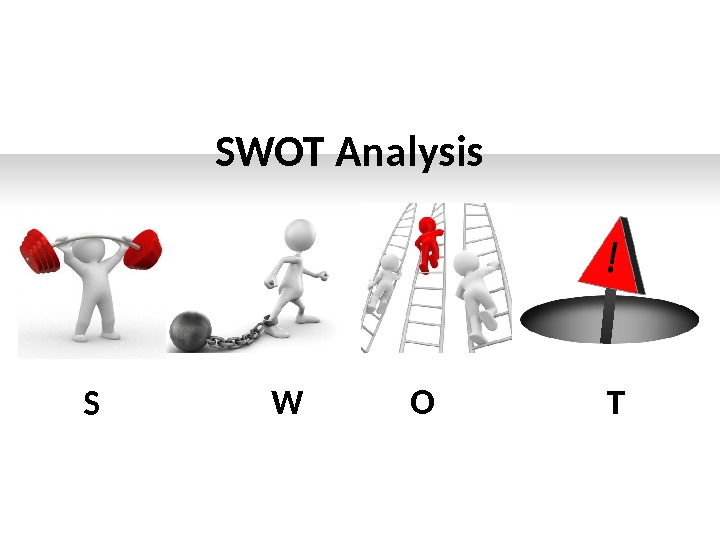
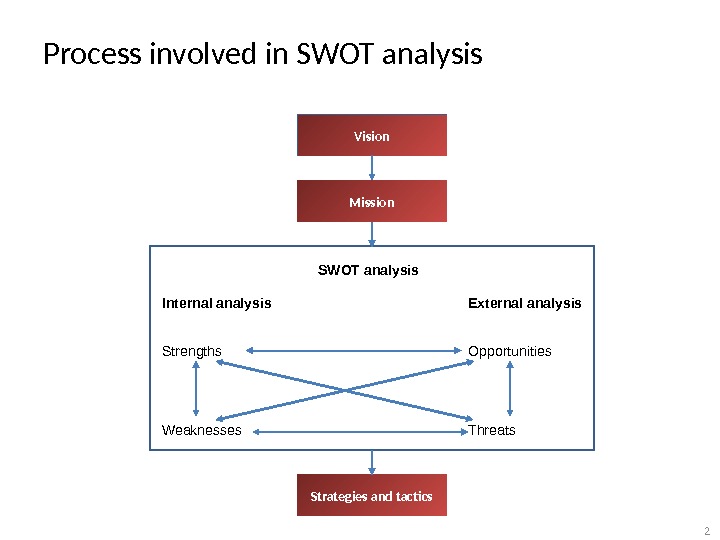
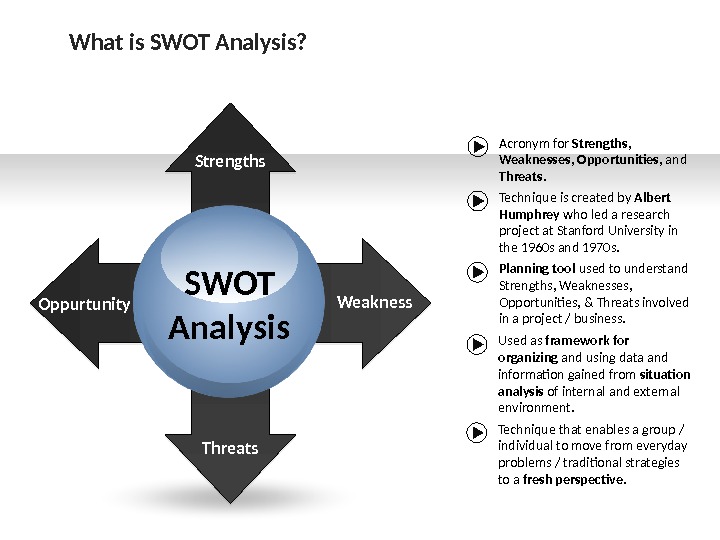
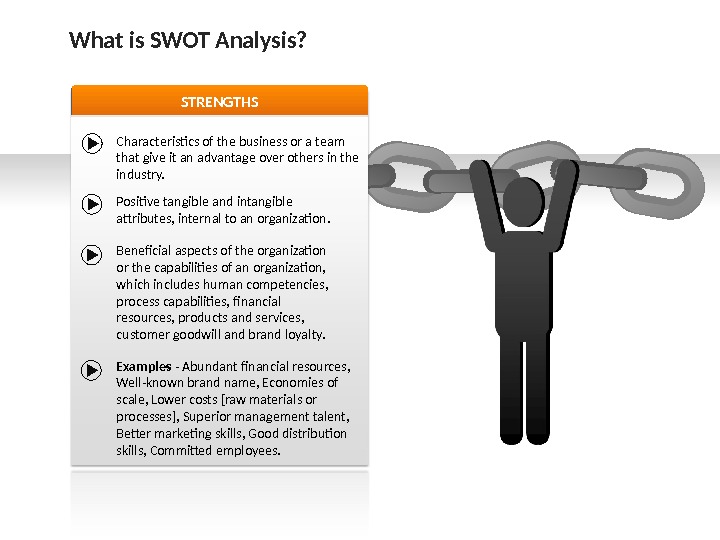
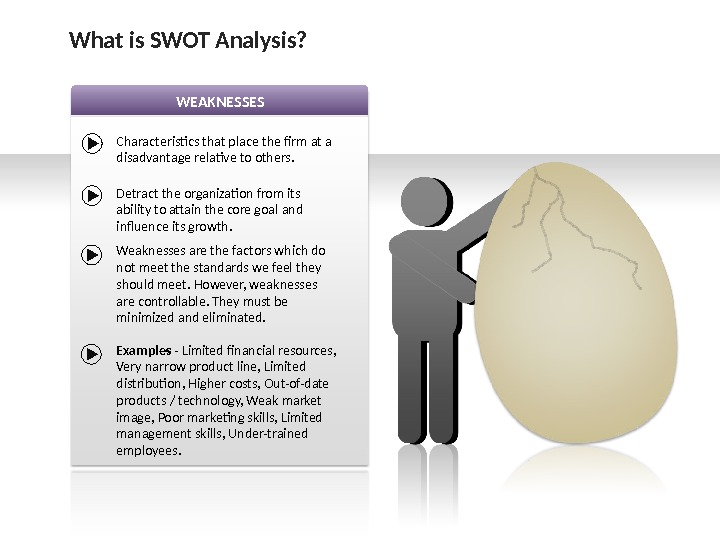
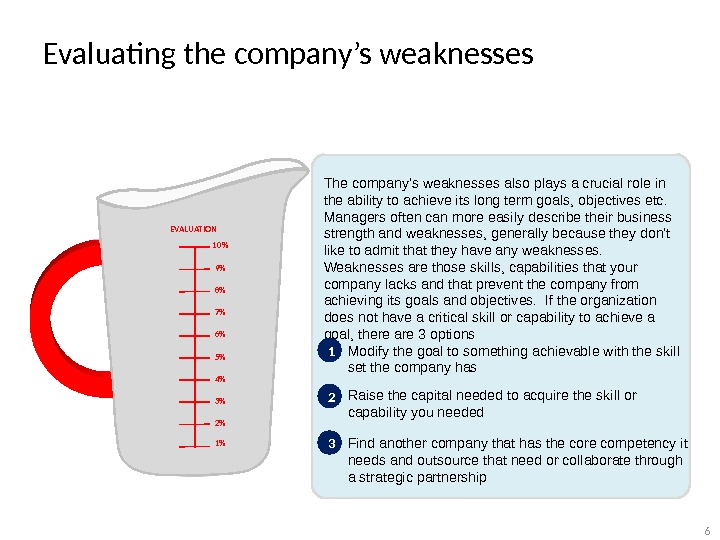
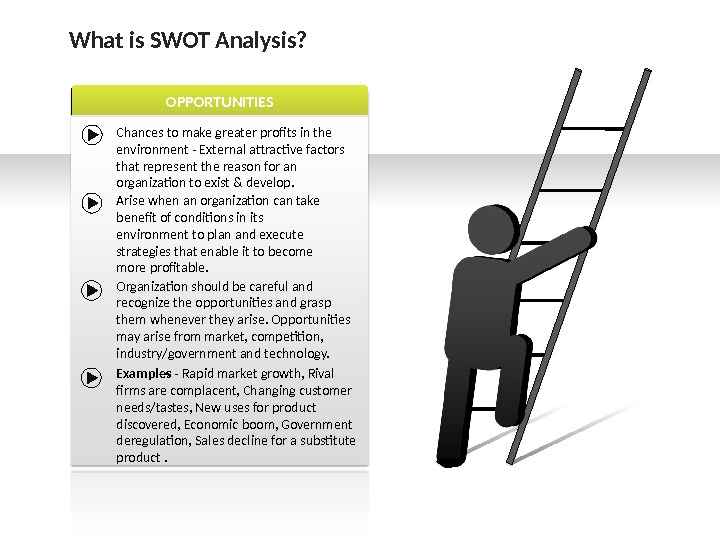

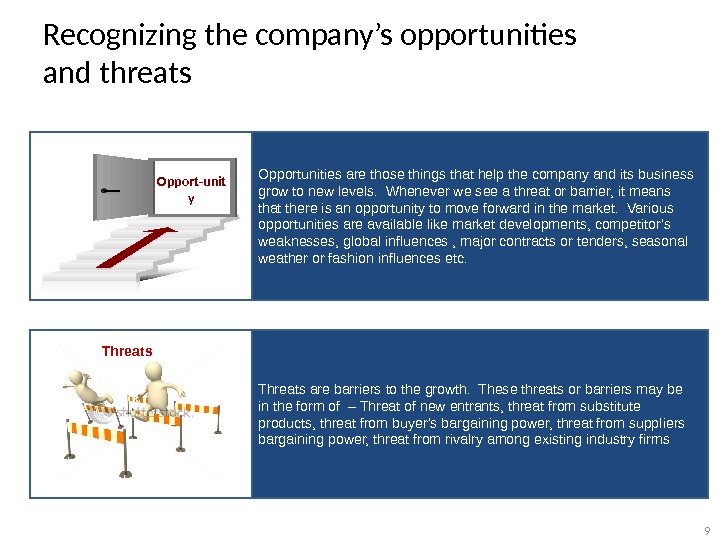
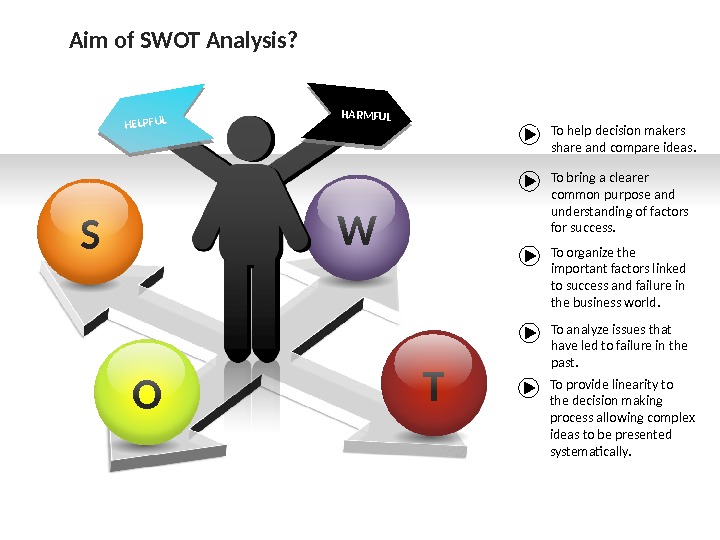
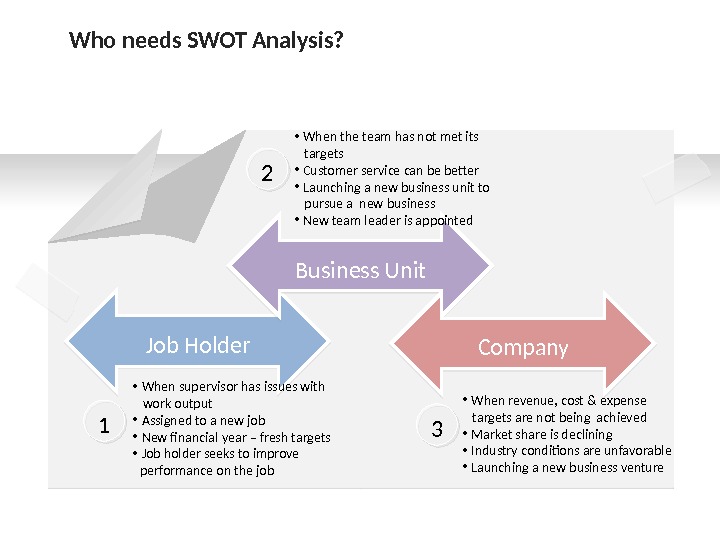

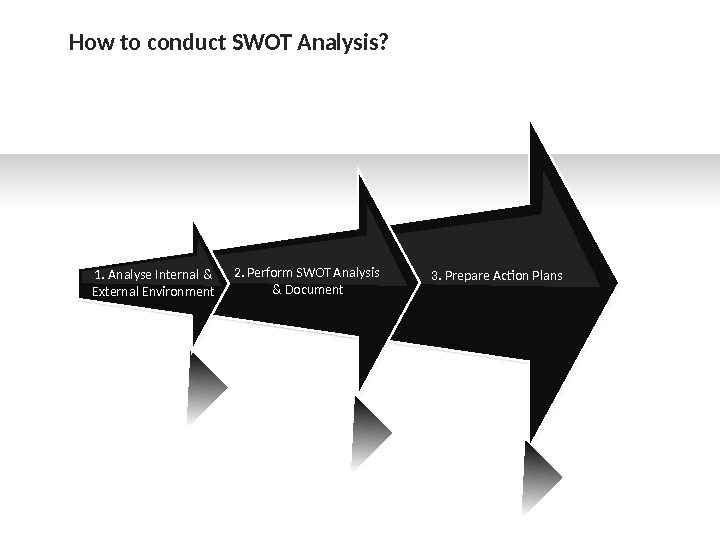
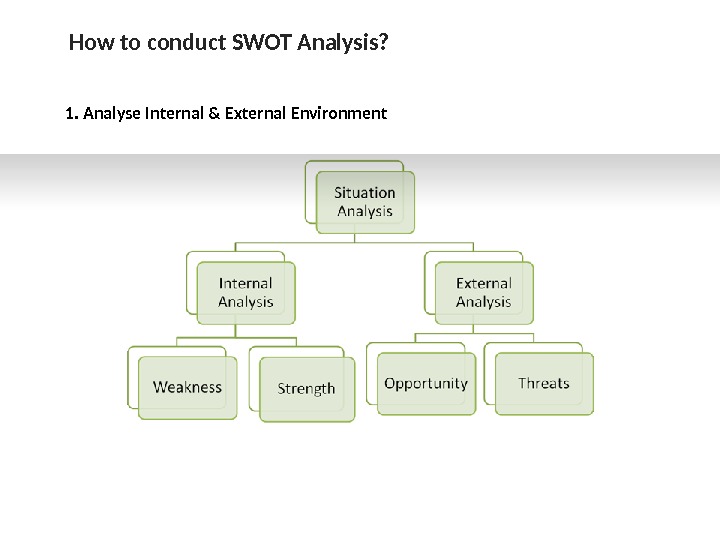
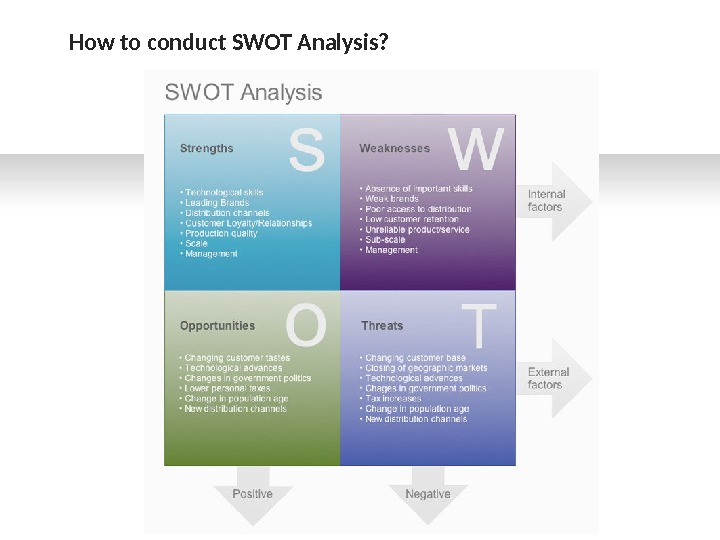
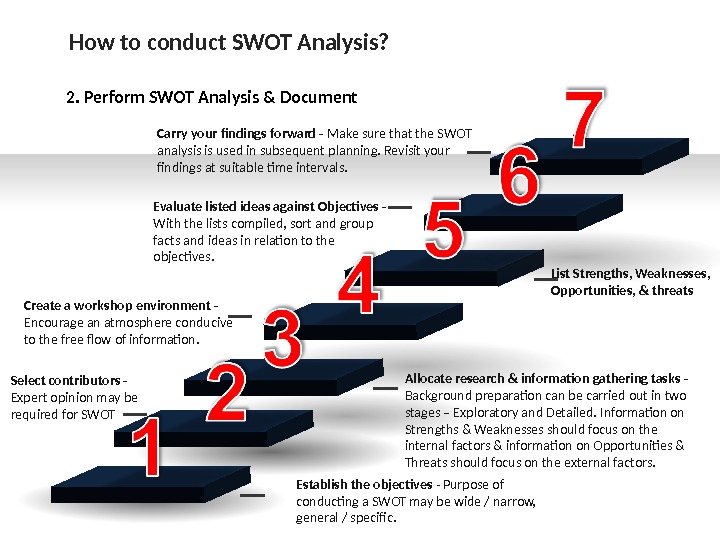
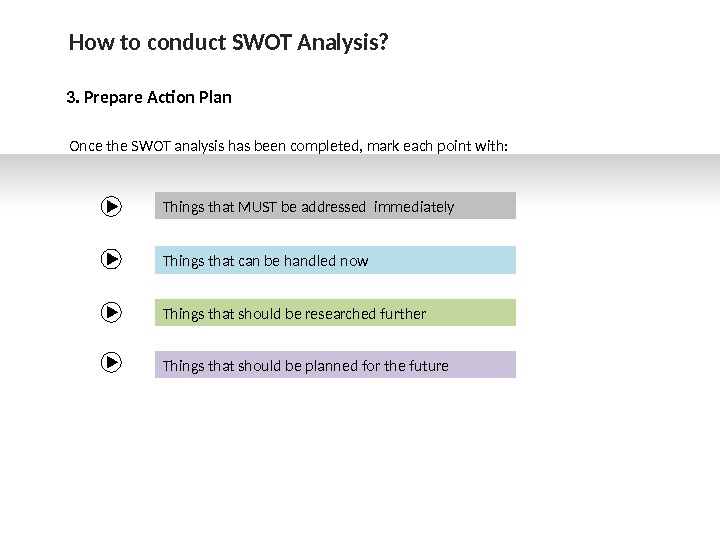
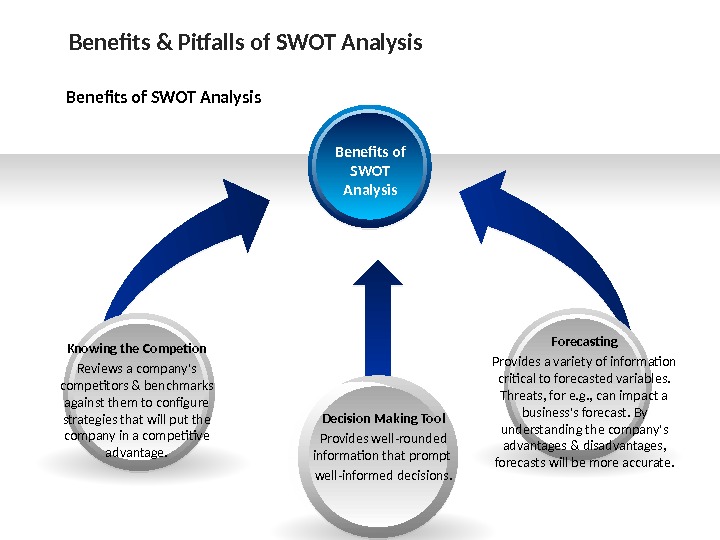

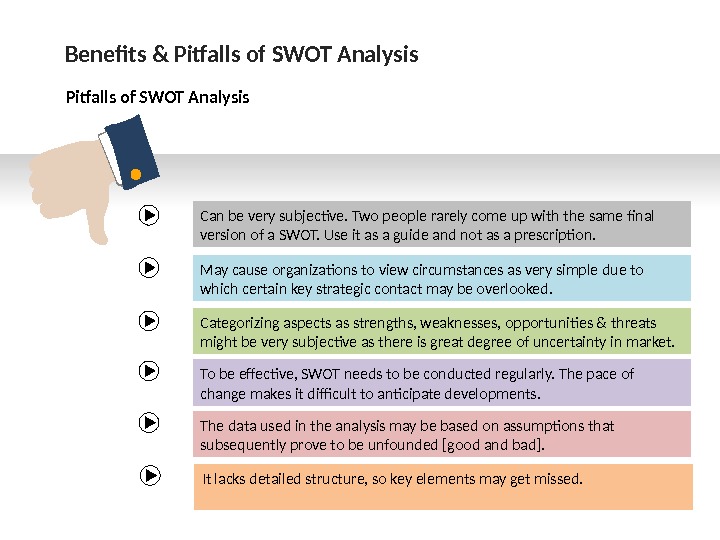
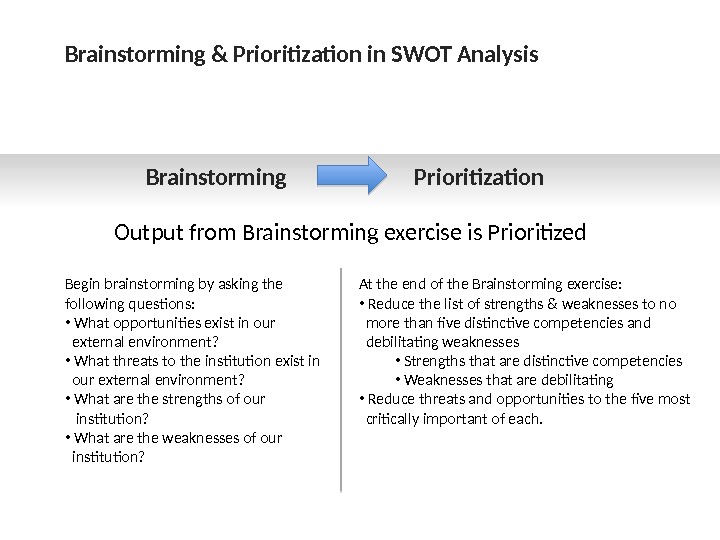
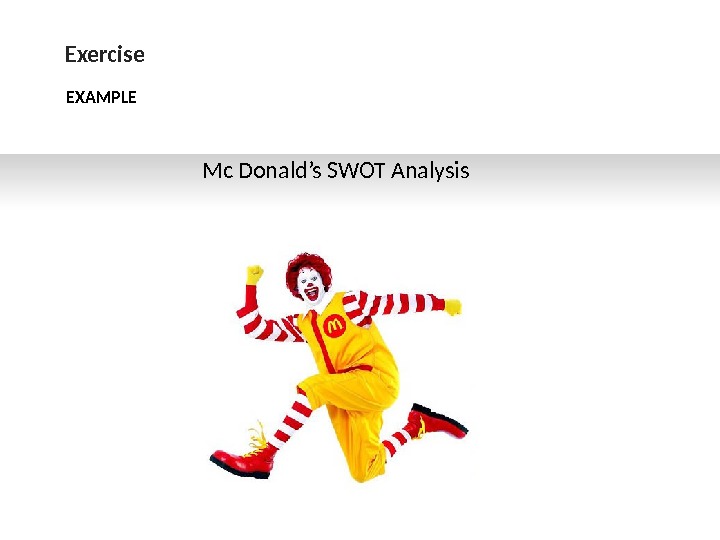
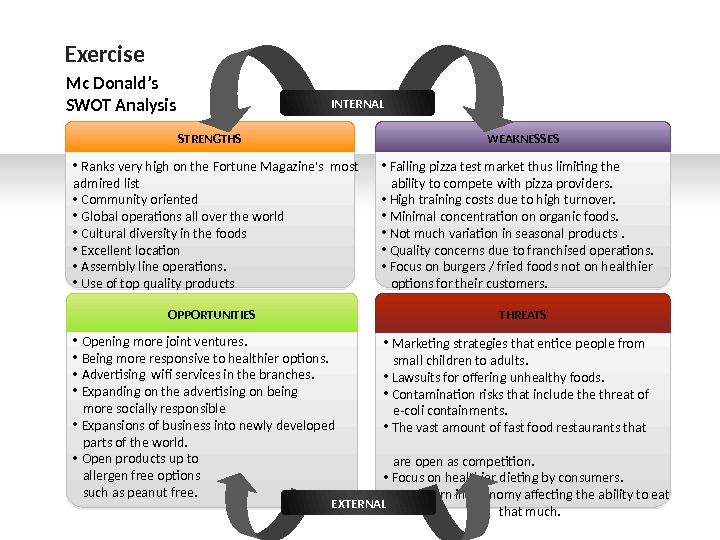

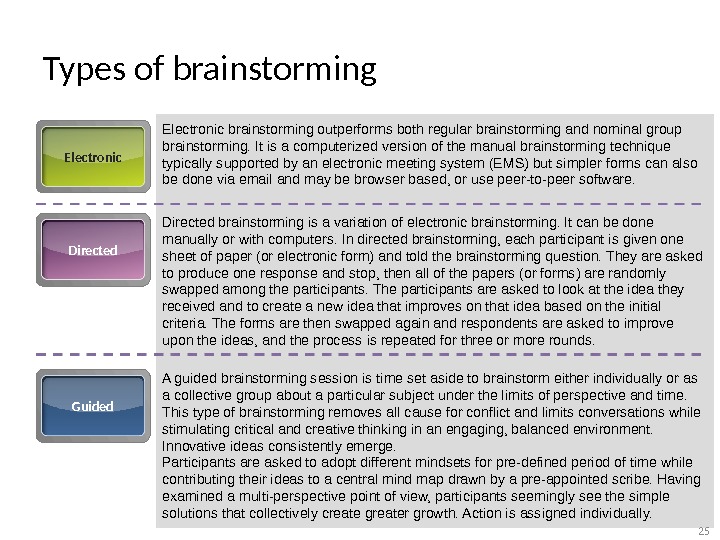

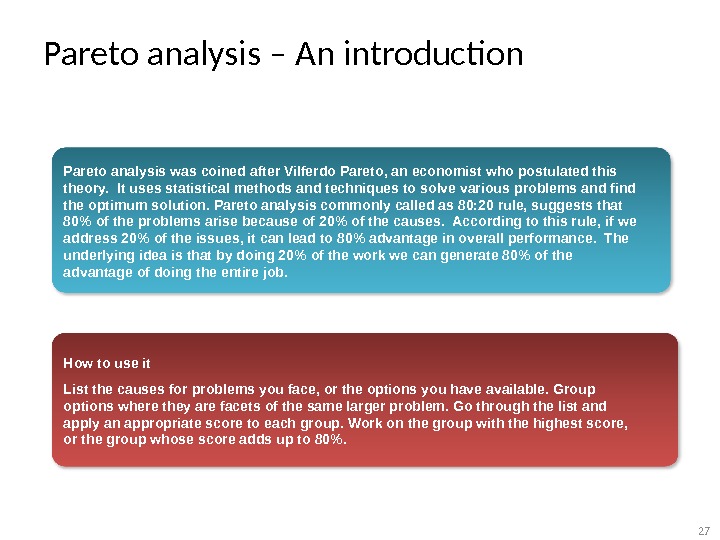
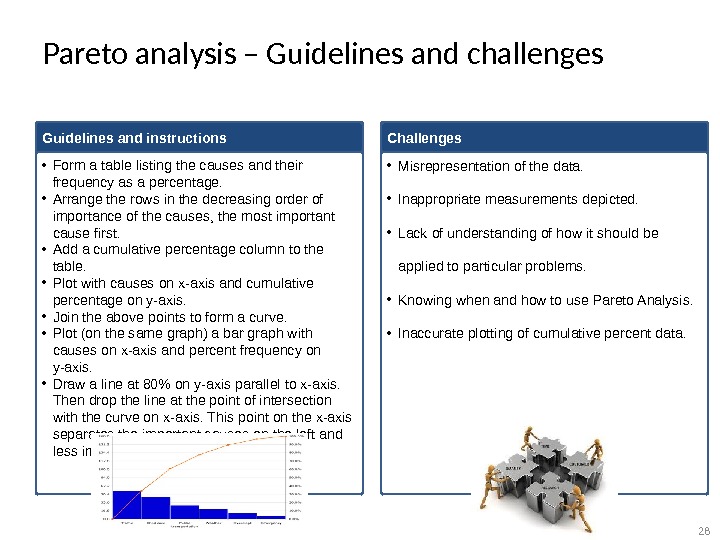

- Размер: 3.1 Mегабайта
- Количество слайдов: 29
Описание презентации SWOT Analysis S W O T Process по слайдам
 SWOT Analysis S W O T
SWOT Analysis S W O T
 Process involved in SWOT analysis Internal analysis Strengths Weaknesses External analysis Opportunities Threats. Vision Mission Strategies and tactics
Process involved in SWOT analysis Internal analysis Strengths Weaknesses External analysis Opportunities Threats. Vision Mission Strategies and tactics
 SWOT Analysis. Oppurtunity Threats. Strengths Weakness Acronym for Strengths , Weaknesses , Opportunities , and Threats. Technique is created by Albert Humphrey who led a research project at Stanford University in the 1960 s and 1970 s. Planning tool used to understand Strengths, Weaknesses, Opportunities, & Threats involved in a project / business. Used as framework for organizing and using data and information gained from situation analysis of internal and external environment. Technique that enables a group / individual to move from everyday problems / traditional strategies to a fresh perspective. What is SWOT Analysis?
SWOT Analysis. Oppurtunity Threats. Strengths Weakness Acronym for Strengths , Weaknesses , Opportunities , and Threats. Technique is created by Albert Humphrey who led a research project at Stanford University in the 1960 s and 1970 s. Planning tool used to understand Strengths, Weaknesses, Opportunities, & Threats involved in a project / business. Used as framework for organizing and using data and information gained from situation analysis of internal and external environment. Technique that enables a group / individual to move from everyday problems / traditional strategies to a fresh perspective. What is SWOT Analysis?
 STRENGTHS Characteristics of the business or a team that give it an advantage over others in the industry. Positive tangible and intangible attributes, internal to an organization. Beneficial aspects of the organization or the capabilities of an organization, which includes human competencies, process capabilities, financial resources, products and services, customer goodwill and brand loyalty. Examples — Abundant financial resources, Well-known brand name, Economies of scale, Lower costs [raw materials or processes], Superior management talent, Better marketing skills, Good distribution skills, Committed employees. What is SWOT Analysis?
STRENGTHS Characteristics of the business or a team that give it an advantage over others in the industry. Positive tangible and intangible attributes, internal to an organization. Beneficial aspects of the organization or the capabilities of an organization, which includes human competencies, process capabilities, financial resources, products and services, customer goodwill and brand loyalty. Examples — Abundant financial resources, Well-known brand name, Economies of scale, Lower costs [raw materials or processes], Superior management talent, Better marketing skills, Good distribution skills, Committed employees. What is SWOT Analysis?
 WEAKNESSES Characteristics that place the firm at a disadvantage relative to others. Detract the organization from its ability to attain the core goal and influence its growth. Weaknesses are the factors which do not meet the standards we feel they should meet. However, weaknesses are controllable. They must be minimized and eliminated. Examples — Limited financial resources, Very narrow product line, Limited distribution, Higher costs, Out-of-date products / technology, Weak market image, Poor marketing skills, Limited management skills, Under-trained employees. What is SWOT Analysis?
WEAKNESSES Characteristics that place the firm at a disadvantage relative to others. Detract the organization from its ability to attain the core goal and influence its growth. Weaknesses are the factors which do not meet the standards we feel they should meet. However, weaknesses are controllable. They must be minimized and eliminated. Examples — Limited financial resources, Very narrow product line, Limited distribution, Higher costs, Out-of-date products / technology, Weak market image, Poor marketing skills, Limited management skills, Under-trained employees. What is SWOT Analysis?
 Evaluating the company’s weaknesses The company’s weaknesses also plays a crucial role in the ability to achieve its long term goals, objectives etc. Managers often can more easily describe their business strength and weaknesses, generally because they don’t like to admit that they have any weaknesses. Weaknesses are those skills, capabilities that your company lacks and that prevent the company from achieving its goals and objectives. If the organization does not have a critical skill or capability to achieve a goal, there are 3 options 1 Modify the goal to something achievable with the skill set the company has 2 Raise the capital needed to acquire the skill or capability you needed 3 Find another company that has the core competency it needs and outsource that need or collaborate through a strategic partnership 1%2%3%4%5%6%7%8%9%10%EVALUATION
Evaluating the company’s weaknesses The company’s weaknesses also plays a crucial role in the ability to achieve its long term goals, objectives etc. Managers often can more easily describe their business strength and weaknesses, generally because they don’t like to admit that they have any weaknesses. Weaknesses are those skills, capabilities that your company lacks and that prevent the company from achieving its goals and objectives. If the organization does not have a critical skill or capability to achieve a goal, there are 3 options 1 Modify the goal to something achievable with the skill set the company has 2 Raise the capital needed to acquire the skill or capability you needed 3 Find another company that has the core competency it needs and outsource that need or collaborate through a strategic partnership 1%2%3%4%5%6%7%8%9%10%EVALUATION
 OPPORTUNITIESWhat is SWOT Analysis? Chances to make greater profits in the environment — External attractive factors that represent the reason for an organization to exist & develop. Arise when an organization can take benefit of conditions in its environment to plan and execute strategies that enable it to become more profitable. Organization should be careful and recognize the opportunities and grasp them whenever they arise. Opportunities may arise from market, competition, industry/government and technology. Examples — Rapid market growth, Rival firms are complacent, Changing customer needs/tastes, New uses for product discovered, Economic boom, Government deregulation, Sales decline for a substitute product.
OPPORTUNITIESWhat is SWOT Analysis? Chances to make greater profits in the environment — External attractive factors that represent the reason for an organization to exist & develop. Arise when an organization can take benefit of conditions in its environment to plan and execute strategies that enable it to become more profitable. Organization should be careful and recognize the opportunities and grasp them whenever they arise. Opportunities may arise from market, competition, industry/government and technology. Examples — Rapid market growth, Rival firms are complacent, Changing customer needs/tastes, New uses for product discovered, Economic boom, Government deregulation, Sales decline for a substitute product.
 SWOT ANALYSIS — THREAT !THREATSWhat is SWOT Analysis? External elements in the environment that could cause trouble for the business — External factors, beyond an organization’s control, which could place the organization’s mission or operation at risk. Arise when conditions in external environment jeopardize the reliability and profitability of the organization’s business. Compound the vulnerability when they relate to the weaknesses. Threats are uncontrollable. When a threat comes, the stability and survival can be at stake. Examples — Entry of foreign competitors, Introduction of new substitute products, Product life cycle in decline, Changing customer needs/tastes, Rival firms adopt new strategies, Increased government regulation, Economic downturn.
SWOT ANALYSIS — THREAT !THREATSWhat is SWOT Analysis? External elements in the environment that could cause trouble for the business — External factors, beyond an organization’s control, which could place the organization’s mission or operation at risk. Arise when conditions in external environment jeopardize the reliability and profitability of the organization’s business. Compound the vulnerability when they relate to the weaknesses. Threats are uncontrollable. When a threat comes, the stability and survival can be at stake. Examples — Entry of foreign competitors, Introduction of new substitute products, Product life cycle in decline, Changing customer needs/tastes, Rival firms adopt new strategies, Increased government regulation, Economic downturn.
 Recognizing the company’s opportunities and threats Opport-unit y Opportunities are those things that help the company and its business grow to new levels. Whenever we see a threat or barrier, it means that there is an opportunity to move forward in the market. Various opportunities are available like market developments, competitor’s weaknesses, global influences , major contracts or tenders, seasonal weather or fashion influences etc. Threats are barriers to the growth. These threats or barriers may be in the form of – Threat of new entrants, threat from substitute products, threat from buyer’s bargaining power, threat from suppliers bargaining power, threat from rivalry among existing industry firms. Threats
Recognizing the company’s opportunities and threats Opport-unit y Opportunities are those things that help the company and its business grow to new levels. Whenever we see a threat or barrier, it means that there is an opportunity to move forward in the market. Various opportunities are available like market developments, competitor’s weaknesses, global influences , major contracts or tenders, seasonal weather or fashion influences etc. Threats are barriers to the growth. These threats or barriers may be in the form of – Threat of new entrants, threat from substitute products, threat from buyer’s bargaining power, threat from suppliers bargaining power, threat from rivalry among existing industry firms. Threats
 HELPFULHARMFULS W T O To help decision makers share and compare ideas. To bring a clearer common purpose and understanding of factors for success. To organize the important factors linked to success and failure in the business world. To analyze issues that have led to failure in the past. Aim of SWOT Analysis? To provide linearity to the decision making process allowing complex ideas to be presented systematically.
HELPFULHARMFULS W T O To help decision makers share and compare ideas. To bring a clearer common purpose and understanding of factors for success. To organize the important factors linked to success and failure in the business world. To analyze issues that have led to failure in the past. Aim of SWOT Analysis? To provide linearity to the decision making process allowing complex ideas to be presented systematically.
 Job Holder • When supervisor has issues with work output • Assigned to a new job • New financial year – fresh targets • Job holder seeks to improve performance on the job 1 Business Unit 2 • When the team has not met its targets • Customer service can be better • Launching a new business unit to pursue a new business • New team leader is appointed Company • When revenue, cost & expense targets are not being achieved • Market share is declining • Industry conditions are unfavorable • Launching a new business venture 3 Who needs SWOT Analysis?
Job Holder • When supervisor has issues with work output • Assigned to a new job • New financial year – fresh targets • Job holder seeks to improve performance on the job 1 Business Unit 2 • When the team has not met its targets • Customer service can be better • Launching a new business unit to pursue a new business • New team leader is appointed Company • When revenue, cost & expense targets are not being achieved • Market share is declining • Industry conditions are unfavorable • Launching a new business venture 3 Who needs SWOT Analysis?
 Workshop Sessions Brainstorming Meetings. Strategic Planning Product Evaluation. Competitor Evaluation Personal Development Planning Decision Making. Product Launch Changing Jobs. Who needs SWOT Analysis? SWOT Analysis is also required for / during. . .
Workshop Sessions Brainstorming Meetings. Strategic Planning Product Evaluation. Competitor Evaluation Personal Development Planning Decision Making. Product Launch Changing Jobs. Who needs SWOT Analysis? SWOT Analysis is also required for / during. . .
 3. Prepare Action Plans 2. Perform SWOT Analysis & Document 1. Analyse Internal & External Environment. How to conduct SWOT Analysis?
3. Prepare Action Plans 2. Perform SWOT Analysis & Document 1. Analyse Internal & External Environment. How to conduct SWOT Analysis?
 How to conduct SWOT Analysis? 1. Analyse Internal & External Environment
How to conduct SWOT Analysis? 1. Analyse Internal & External Environment
 How to conduct SWOT Analysis?
How to conduct SWOT Analysis?
 Carry your findings forward — Make sure that the SWOT analysis is used in subsequent planning. Revisit your findings at suitable time intervals. Create a workshop environment — Encourage an atmosphere conducive to the free flow of information. Allocate research & information gathering tasks — Background preparation can be carried out in two stages – Exploratory and Detailed. Information on Strengths & Weaknesses should focus on the internal factors & information on Opportunities & Threats should focus on the external factors. Select contributors — Expert opinion may be required for SWOT Establish the objectives — Purpose of conducting a SWOT may be wide / narrow, general / specific. Evaluate listed ideas against Objectives — With the lists compiled, sort and group facts and ideas in relation to the objectives. List Strengths, Weaknesses, Opportunities, & threats. How to conduct SWOT Analysis? 2. Perform SWOT Analysis & Document
Carry your findings forward — Make sure that the SWOT analysis is used in subsequent planning. Revisit your findings at suitable time intervals. Create a workshop environment — Encourage an atmosphere conducive to the free flow of information. Allocate research & information gathering tasks — Background preparation can be carried out in two stages – Exploratory and Detailed. Information on Strengths & Weaknesses should focus on the internal factors & information on Opportunities & Threats should focus on the external factors. Select contributors — Expert opinion may be required for SWOT Establish the objectives — Purpose of conducting a SWOT may be wide / narrow, general / specific. Evaluate listed ideas against Objectives — With the lists compiled, sort and group facts and ideas in relation to the objectives. List Strengths, Weaknesses, Opportunities, & threats. How to conduct SWOT Analysis? 2. Perform SWOT Analysis & Document
 How to conduct SWOT Analysis? 3. Prepare Action Plan Things that MUST be addressed immediately Once the SWOT analysis has been completed, mark each point with: Things that can be handled now Things that should be researched further Things that should be planned for the future
How to conduct SWOT Analysis? 3. Prepare Action Plan Things that MUST be addressed immediately Once the SWOT analysis has been completed, mark each point with: Things that can be handled now Things that should be researched further Things that should be planned for the future
 Benefits & Pitfalls of SWOT Analysis Benefits of SWOT Analysis Forecasting Provides a variety of information critical to forecasted variables. Threats, for e. g. , can impact a business’s forecast. By understanding the company’s advantages & disadvantages, forecasts will be more accurate. Decision Making Tool Provides well-rounded information that prompt well-informed decisions. Knowing the Competion Reviews a company’s competitors & benchmarks against them to configure strategies that will put the company in a competitive advantage. Benefits of SWOT Analysis
Benefits & Pitfalls of SWOT Analysis Benefits of SWOT Analysis Forecasting Provides a variety of information critical to forecasted variables. Threats, for e. g. , can impact a business’s forecast. By understanding the company’s advantages & disadvantages, forecasts will be more accurate. Decision Making Tool Provides well-rounded information that prompt well-informed decisions. Knowing the Competion Reviews a company’s competitors & benchmarks against them to configure strategies that will put the company in a competitive advantage. Benefits of SWOT Analysis
 Benefits & Pitfalls of SWOT Analysis Benefits of SWOT Analysis Helps in setting of objectives for strategic planning. Besides the broad benefits, here are few more benefits of conducting SWOT Analysis: Provides a framework for identifying & analyzing strengths, weaknesses, opportunities & threats Provides an impetus to analyze a situation & develop suitable strategies and tactics Basis for assessing core capabilities & competencies Evidence for, and cultural key to, change Provides a stimulus to participation in a group experience
Benefits & Pitfalls of SWOT Analysis Benefits of SWOT Analysis Helps in setting of objectives for strategic planning. Besides the broad benefits, here are few more benefits of conducting SWOT Analysis: Provides a framework for identifying & analyzing strengths, weaknesses, opportunities & threats Provides an impetus to analyze a situation & develop suitable strategies and tactics Basis for assessing core capabilities & competencies Evidence for, and cultural key to, change Provides a stimulus to participation in a group experience
 Benefits & Pitfalls of SWOT Analysis Can be very subjective. Two people rarely come up with the same final version of a SWOT. Use it as a guide and not as a prescription. May cause organizations to view circumstances as very simple due to which certain key strategic contact may be overlooked. Categorizing aspects as strengths, weaknesses, opportunities & threats might be very subjective as there is great degree of uncertainty in market. To be effective, SWOT needs to be conducted regularly. The pace of change makes it difficult to anticipate developments. The data used in the analysis may be based on assumptions that subsequently prove to be unfounded [good and bad]. It lacks detailed structure, so key elements may get missed.
Benefits & Pitfalls of SWOT Analysis Can be very subjective. Two people rarely come up with the same final version of a SWOT. Use it as a guide and not as a prescription. May cause organizations to view circumstances as very simple due to which certain key strategic contact may be overlooked. Categorizing aspects as strengths, weaknesses, opportunities & threats might be very subjective as there is great degree of uncertainty in market. To be effective, SWOT needs to be conducted regularly. The pace of change makes it difficult to anticipate developments. The data used in the analysis may be based on assumptions that subsequently prove to be unfounded [good and bad]. It lacks detailed structure, so key elements may get missed.
 Brainstorming & Prioritization in SWOT Analysis Brainstorming Prioritization Output from Brainstorming exercise is Prioritized Begin brainstorming by asking the following questions: • What opportunities exist in our external environment? • What threats to the institution exist in our external environment? • What are the strengths of our institution? • What are the weaknesses of our institution? At the end of the Brainstorming exercise: • Reduce the list of strengths & weaknesses to no more than five distinctive competencies and debilitating weaknesses • Strengths that are distinctive competencies • Weaknesses that are debilitating • Reduce threats and opportunities to the five most critically important of each.
Brainstorming & Prioritization in SWOT Analysis Brainstorming Prioritization Output from Brainstorming exercise is Prioritized Begin brainstorming by asking the following questions: • What opportunities exist in our external environment? • What threats to the institution exist in our external environment? • What are the strengths of our institution? • What are the weaknesses of our institution? At the end of the Brainstorming exercise: • Reduce the list of strengths & weaknesses to no more than five distinctive competencies and debilitating weaknesses • Strengths that are distinctive competencies • Weaknesses that are debilitating • Reduce threats and opportunities to the five most critically important of each.
 Exercise EXAMPLE Mc Donald’s SWOT Analysis
Exercise EXAMPLE Mc Donald’s SWOT Analysis
 WEAKNESSES • Failing pizza test market thus limiting the ability to compete with pizza providers. • High training costs due to high turnover. • Minimal concentration on organic foods. • Not much variation in seasonal products. • Quality concerns due to franchised operations. • Focus on burgers / fried foods not on healthier options for their customers. • Ranks very high on the Fortune Magazine’s most admired list • Community oriented • Global operations all over the world • Cultural diversity in the foods • Excellent location • Assembly line operations. • Use of top quality products STRENGTHS INTERNAL • Marketing strategies that entice people from small children to adults. • Lawsuits for offering unhealthy foods. • Contamination risks that include threat of e-coli containments. • The vast amount of fast food restaurants that are open as competition. • Focus on healthier dieting by consumers. • Down turn in economy affecting the ability to eat that much. THREATS • Opening more joint ventures. • Being more responsive to healthier options. • Advertising wifi services in the branches. • Expanding on the advertising on being more socially responsible • Expansions of business into newly developed parts of the world. • Open products up to allergen free options such as peanut free. OPPORTUNITIES EXTERNALExercise Mc Donald’s SWOT Analysis
WEAKNESSES • Failing pizza test market thus limiting the ability to compete with pizza providers. • High training costs due to high turnover. • Minimal concentration on organic foods. • Not much variation in seasonal products. • Quality concerns due to franchised operations. • Focus on burgers / fried foods not on healthier options for their customers. • Ranks very high on the Fortune Magazine’s most admired list • Community oriented • Global operations all over the world • Cultural diversity in the foods • Excellent location • Assembly line operations. • Use of top quality products STRENGTHS INTERNAL • Marketing strategies that entice people from small children to adults. • Lawsuits for offering unhealthy foods. • Contamination risks that include threat of e-coli containments. • The vast amount of fast food restaurants that are open as competition. • Focus on healthier dieting by consumers. • Down turn in economy affecting the ability to eat that much. THREATS • Opening more joint ventures. • Being more responsive to healthier options. • Advertising wifi services in the branches. • Expanding on the advertising on being more socially responsible • Expansions of business into newly developed parts of the world. • Open products up to allergen free options such as peanut free. OPPORTUNITIES EXTERNALExercise Mc Donald’s SWOT Analysis
 Brainstorming is a popular method of group interaction in both educational and business settings. Even though there have been arguments about its productivity, brainstorming is still a widely used method for developing creative solutions. It’s an area that is under research and improvements or variations are still developing. Many of these methods claim to be more efficient than the original brainstorming; however, there are too many factors that can alter the outcome of brainstorming.
Brainstorming is a popular method of group interaction in both educational and business settings. Even though there have been arguments about its productivity, brainstorming is still a widely used method for developing creative solutions. It’s an area that is under research and improvements or variations are still developing. Many of these methods claim to be more efficient than the original brainstorming; however, there are too many factors that can alter the outcome of brainstorming.
 Types of brainstorming Electronic brainstorming outperforms both regular brainstorming and nominal group brainstorming. It is a computerized version of the manual brainstorming technique typically supported by an electronic meeting system (EMS) but simpler forms can also be done via email and may be browser based, or use peer-to-peer software. Directed brainstorming is a variation of electronic brainstorming. It can be done manually or with computers. In directed brainstorming, each participant is given one sheet of paper (or electronic form) and told the brainstorming question. They are asked to produce one response and stop, then all of the papers (or forms) are randomly swapped among the participants. The participants are asked to look at the idea they received and to create a new idea that improves on that idea based on the initial criteria. The forms are then swapped again and respondents are asked to improve upon the ideas, and the process is repeated for three or more rounds. Guided A guided brainstorming session is time set aside to brainstorm either individually or as a collective group about a particular subject under the limits of perspective and time. This type of brainstorming removes all cause for conflict and limits conversations while stimulating critical and creative thinking in an engaging, balanced environment. Innovative ideas consistently emerge. Participants are asked to adopt different mindsets for pre-defined period of time while contributing their ideas to a central mind map drawn by a pre-appointed scribe. Having examined a multi-perspective point of view, participants seemingly see the simple solutions that collectively create greater growth. Action is assigned individually.
Types of brainstorming Electronic brainstorming outperforms both regular brainstorming and nominal group brainstorming. It is a computerized version of the manual brainstorming technique typically supported by an electronic meeting system (EMS) but simpler forms can also be done via email and may be browser based, or use peer-to-peer software. Directed brainstorming is a variation of electronic brainstorming. It can be done manually or with computers. In directed brainstorming, each participant is given one sheet of paper (or electronic form) and told the brainstorming question. They are asked to produce one response and stop, then all of the papers (or forms) are randomly swapped among the participants. The participants are asked to look at the idea they received and to create a new idea that improves on that idea based on the initial criteria. The forms are then swapped again and respondents are asked to improve upon the ideas, and the process is repeated for three or more rounds. Guided A guided brainstorming session is time set aside to brainstorm either individually or as a collective group about a particular subject under the limits of perspective and time. This type of brainstorming removes all cause for conflict and limits conversations while stimulating critical and creative thinking in an engaging, balanced environment. Innovative ideas consistently emerge. Participants are asked to adopt different mindsets for pre-defined period of time while contributing their ideas to a central mind map drawn by a pre-appointed scribe. Having examined a multi-perspective point of view, participants seemingly see the simple solutions that collectively create greater growth. Action is assigned individually.
 Types of brainstorming Individual «Individual brainstorming» is the use of brainstorming in solitary. It typically includes such techniques as free writing, free speaking, word association, and drawing a mind map, which is a visual note taking technique in which people diagram their thoughts. Individual brainstorming is a useful method in creative writing and has been shown to be superior to traditional group brainstorming. Research has shown individual brainstorming to be more effective in idea-generation than group brainstorming. Question This process involves brainstorming the questions, rather than trying to come up with immediate answers and short term solutions. Theoretically, this technique should not inhibit participation as there is no need to provide solutions. The answers to the questions form the framework for constructing future action plans. Once the list of questions is set, it may be necessary to prioritize them to reach to the best solution in an orderly way. «Questorming» is another phrase for this mode of inquiry
Types of brainstorming Individual «Individual brainstorming» is the use of brainstorming in solitary. It typically includes such techniques as free writing, free speaking, word association, and drawing a mind map, which is a visual note taking technique in which people diagram their thoughts. Individual brainstorming is a useful method in creative writing and has been shown to be superior to traditional group brainstorming. Research has shown individual brainstorming to be more effective in idea-generation than group brainstorming. Question This process involves brainstorming the questions, rather than trying to come up with immediate answers and short term solutions. Theoretically, this technique should not inhibit participation as there is no need to provide solutions. The answers to the questions form the framework for constructing future action plans. Once the list of questions is set, it may be necessary to prioritize them to reach to the best solution in an orderly way. «Questorming» is another phrase for this mode of inquiry
 Pareto analysis – An introduction Pareto analysis was coined after Vilferdo Pareto, an economist who postulated this theory. It uses statistical methods and techniques to solve various problems and find the optimum solution. Pareto analysis commonly called as 80: 20 rule, suggests that 80% of the problems arise because of 20% of the causes. According to this rule, if we address 20% of the issues, it can lead to 80% advantage in overall performance. The underlying idea is that by doing 20% of the work we can generate 80% of the advantage of doing the entire job. How to use it List the causes for problems you face, or the options you have available. Group options where they are facets of the same larger problem. Go through the list and apply an appropriate score to each group. Work on the group with the highest score, or the group whose score adds up to 80%.
Pareto analysis – An introduction Pareto analysis was coined after Vilferdo Pareto, an economist who postulated this theory. It uses statistical methods and techniques to solve various problems and find the optimum solution. Pareto analysis commonly called as 80: 20 rule, suggests that 80% of the problems arise because of 20% of the causes. According to this rule, if we address 20% of the issues, it can lead to 80% advantage in overall performance. The underlying idea is that by doing 20% of the work we can generate 80% of the advantage of doing the entire job. How to use it List the causes for problems you face, or the options you have available. Group options where they are facets of the same larger problem. Go through the list and apply an appropriate score to each group. Work on the group with the highest score, or the group whose score adds up to 80%.
 Pareto analysis – Guidelines and challenges Guidelines and instructions • Form a table listing the causes and their frequency as a percentage. • Arrange the rows in the decreasing order of importance of the causes, the most important cause first. • Add a cumulative percentage column to the table. • Plot with causes on x-axis and cumulative percentage on y-axis. • Join the above points to form a curve. • Plot (on the same graph) a bar graph with causes on x-axis and percent frequency on y-axis. • Draw a line at 80% on y-axis parallel to x-axis. Then drop the line at the point of intersection with the curve on x-axis. This point on the x-axis separates the important causes on the left and less important causes on the right. Challenges • Misrepresentation of the data. • Inappropriate measurements depicted. • Lack of understanding of how it should be applied to particular problems. • Knowing when and how to use Pareto Analysis. • Inaccurate plotting of cumulative percent data.
Pareto analysis – Guidelines and challenges Guidelines and instructions • Form a table listing the causes and their frequency as a percentage. • Arrange the rows in the decreasing order of importance of the causes, the most important cause first. • Add a cumulative percentage column to the table. • Plot with causes on x-axis and cumulative percentage on y-axis. • Join the above points to form a curve. • Plot (on the same graph) a bar graph with causes on x-axis and percent frequency on y-axis. • Draw a line at 80% on y-axis parallel to x-axis. Then drop the line at the point of intersection with the curve on x-axis. This point on the x-axis separates the important causes on the left and less important causes on the right. Challenges • Misrepresentation of the data. • Inappropriate measurements depicted. • Lack of understanding of how it should be applied to particular problems. • Knowing when and how to use Pareto Analysis. • Inaccurate plotting of cumulative percent data.
 Thank You!
Thank You!

